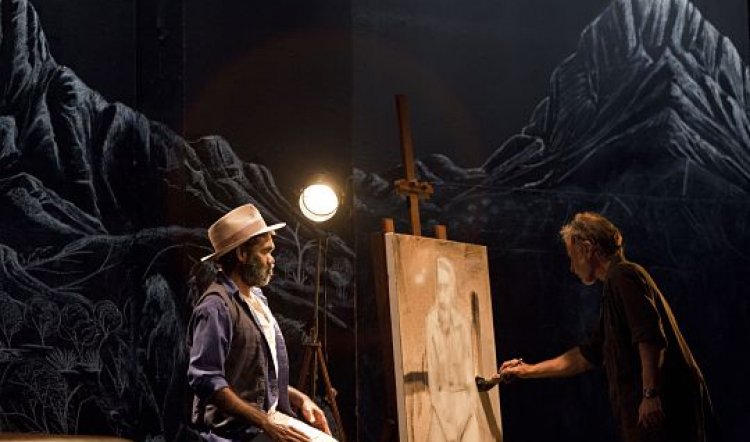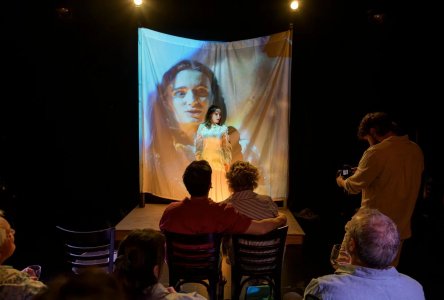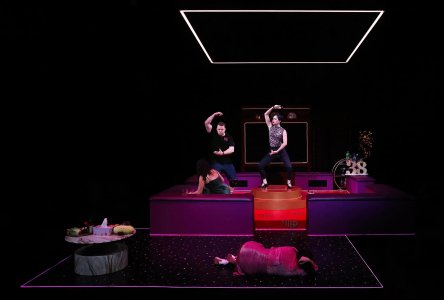
Namatjira
ALBERT NAMATJIRA was, for most white Australians of his time and beyond, the artist that gave them their first real glimpse of the interior of the continent. His watercolour landscapes of the country – around Hermannsburg, west of Alice Springs – revealed the vivid colours, stark beauty and unmistakable terrain and flora of the region as never before. And the rapid commercialisation of his work – cheap prints, tea towels, tea trays and the like – while crass, enabled many of those people to respond to the landscape as never before and claim a bit of it for their lounge room wall or dinner table. Despite all obstacles, Namatjira’s work was popular and profound.
His art has been dismissed by some in the past as sentimental, over-wrought, unrealistic and white-ified, but that’s to misunderstand its genesis and also to be unaware of the landscape and places he was depicting. The truth of the work, as art in the figurative watercolour tradition, cannot be denied or mistaken by anyone fortunate enough to have spent time in Arrente country. At the same time, his personal style, developed over time, is unique and timeless. Many copy but few come near the master. Whichever way you look at him, Namatjira was a great Australian artist whose work was and is universal. (When I was a kid in the bush of south-western Kenya, we had a Namatjira “ghost gum” print on our living room wall. It was all we knew of Australia. Many years later, the first time I went to Hermannsburg the shock of recognition and delight was immense.)
Initially, that same shock of recognition and delight is palpable in writer-director Scott Rankin’s play about the man. But, very quickly, in the mercurial and brilliant person of Trevor Jamieson, those immediate responses are turned upside down. It becomes apparent that what we think we recognise is a convenient and cruel myth; and any inherited notion of delight in the great artist’s success and fame is utterly misplaced. The real story of modern Australia’s first world-famous artist is simultaneously much more terrible and much richer than any tea towel could ever hope to tell.
Born in 1902 on the Lutheran mission at Hermannsburg, we learn that the boy’s name was neither Albert nor Namatjira; but he and the rest of the Arrente kids of the district grew up speaking three languages: their own, German and – post-WW1 – English. Severe drought and poverty coloured his early years; like his father (who wasn’t Namatjira either, by the way) he became a skilled stockman although there wasn’t much money in it and life for he and his wife Rubina and an ever-growing brood of kids, was grim. In 1934 he met Rex Battarbee of Warrnambool; a man crippled by the war but whose only wish was to paint the landscape of Australia’s interior.
The short story is that Albert showed Rex how to handle his country and Rex showed Albert how to handle watercolours; and they became good friends. At some point Battarbee realised that his friend was the better artist and he took on the task of selling Namatjira to the art world down south. The rest is history; but at the same time and not surprisingly, the story has also been hidden from history. Rankin – with the consent and cooperation of Namatjira’s family, and Belvoir’s Wayne Blair – has now stripped off the rosy pink varnish and unveils for the first time who Namatjira was and his tragic and wonderful life and times.
Rankin and Jamieson have worked together before on Ngapartji Ngapartji, also a big hit at Belvoir St and beyond, and this new collaboration shows how much Jamieson has grown since that experience. Always a magnetic performer, he is now an assured, sophisticated and immensely strong one too; and he has to be because the full weight of Namatjira rests on his shoulders. He slips back and forth across the fourth wall, engaging with the audience – drawing in gently with laughter only to cause shocks of disbelief to ripple around the auditorium as laughter gives way to sorrow. He slips in and out of characters – Namatjira, Battarbee, the German missionary – and all the while, maintains a lithe physical presence and awareness of space and time. It’s a remarkable and mesmerising performance.
He’s not entirely on his own, however. Newcomer (to Sydney) Derek Lynch is camp as a row of humpies as the young Queen Elizabeth – who wanted an audience with the artist whose painting she’d liked and acquired – as well as delicious turns as Albert’s long suffering wife Rubina; and a canapé-nibbling, cocktail-sipping Melbourne art patron. He and Jamieson are also mean harmonisers when it comes to delivering the heartfelt choruses of Country songs.

Around the perimeter of the stage, working away silently and symbolically throughout the show on white chalked depictions of Namatjira’s country that finally cover the black painted walls, are various members of his family. In the centre of the space (design Genevieve Dugard) is a multi-layered, highly-polished and sculpted timber structure that could be interpreted as either a representation of the ancient landscape, as Jamieson scrambles over it, or a modern piece that might be admired at the MCA.
Another witty and thought-provoking element in the staging and story-telling is the presence, at the beginning and end of each act, of renowned painter Robert Hannaford. The Archibald winner daubs away, apparently unperturbed or even aware of the audience, at a portrait of Jamieson, seated close by. The idea of the painter painting the painter is a nice one and when the painter is also painting the actor while the historic landscape is being sketched in around them, it makes for a layer of lavish imagining that is all the more effective for being so simple. In all instances, the shadowy Namatjira family members, the brightly captured contemporary artists and the glowing timber in the centre (lighting Nigel Levings) offer much food for thought and contemplation: make of it what you will.
The other spellbinding element of the production is the music and soundscape, played live on stage by Genevieve Lacey. Best known around the world as one of the finest recorder players in the business, this is Lacey’s first outing into theatre and it’s terrific: counterpointing, adding and underlining and always into but not over the action. As well as her customary range of instruments, Lacey brings to this show the rarely seen and scarcely believable contrabass recorder. It stands all by itself and looks like it could have been cobbled together from bits of exhaust pipe, plumbing and farm implements. Amazing!
In the end, however, the grace, dignity and tragedy of Albert Namatjira’s life – at the hands of a racist and paternalistic white society and a rapacious and ever-expectant extended family – is what matters and is delivered with humour and humanity by the entire creative team. For me, one thing encapsulates the artist’s life and times – caught between ancient and modern, white and black – and that is the much-trumpeted fact that Namatjira was the first Aborigine to be granted Australian citizenship. Yet how many knew, until hearing it told by a wryly smiling Trevor Jamieson, that the reason wasn’t noble or just, but merely that Namatjira was making a great deal of money and couldn’t be taxed unless he was a citizen. If it weren’t so awful it would be funny.
Enthralling storytelling, wonderful performances; laugh, cry, marvel and be sad and proud for a great Australian.



